Nazi anti-aircraft towers
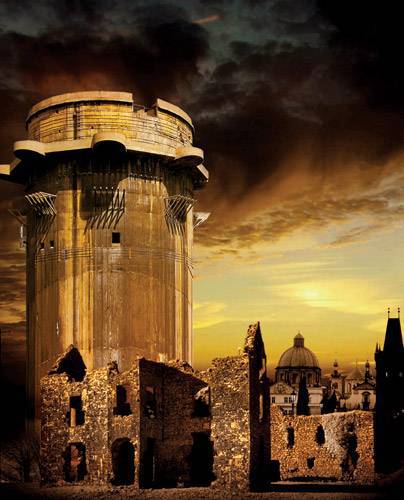
As you know, giant anti-aircraft towers were built only in three major cities of the Reich, but the plans of the Nazis were much more extensive. Three more additional anti-aircraft complexes were supposed to be built in Berlin, and in addition to this, the possibility of re-equipping the Reichstag building into an anti-aircraft tower was considered. Two towers were designed for Bremen, eight - for Munich and one more - for Hamburg. In addition, similar smaller structures were built on the initiative of local authorities in other cities of then-Germany, for example in Königsberg
There were the last days of the storming of Berlin. The capital of the Reich was tightly encircled by Soviet troops, and the army of the two fronts quarter by quarter cleared the city from Wehrmacht soldiers, SS soldiers and Volkshturm fighters. However, Adolf Hitler continued to hope for a miracle. He believed that the army group of SS General Steiner, pretty battered in battles, and hastily knocked out of the fledgling 12-I army of General Wenck, striking from the north and south, would save his hopeless cause.
Where is Venk? .. Where is Steiner? .. When will they be able to launch an offensive? The dying nation must fight to the last German! .. Desperate questions and hysterical orders of the Fuhrer came to the troops in the form of encrypted radiograms via radio communications complex, hidden behind the impregnable walls of the L tower of the air defense complex in Tirgarten, a Berlin zoo. In the neighborhood stood a much more impressive-sized tower "G". In these two cyclopean structures with 2,5-meter walls of heavy-duty concrete, one of the last scenes of the Berlin fall drama was played out.
The G tower, built primarily as an anti-aircraft battery base, had a height of an 13-storey building, even though there were seven floors. Inside there was a hospital, stored museum valuables, but most importantly - tens of thousands of Berliners were saved there from bombs, shells and bullets. When the forces of the attackers approached the center of the city, more than 30 000 people gathered in the Trigar G tower. Of course, there was not enough room for everyone. People stood in the aisles, sat on the stairs, slept side by side. In the hospital, the wounded died, some of the civilians could not stand their nerves, and they committed suicide by taking poison. Half a thousand dead remained right there, alongside the living, since no one would dare to go outside to put their bodies to the ground. The air behind the concrete walls of the tower was literally packed with smashing lead.
The anti-aircraft fortress in Tiergarten, unlike the Reichstag, was never taken by storm. She was surrendered to the Soviet troops 2 in May 1945, when the commander of the defense of Berlin, General Weidling ordered his troops to fold weapon. After the war, the Tiergarten towers and two other similar complexes of the Berlin Air Defense were demolished. The sappers had to suffer with the demolition of buildings that did not take any bombs or shells, and the result was not achieved on the first attempt. It is said that one night, on the wall of one of the towers that had not yet submitted to the British demolition men, someone, not without pride, painted on the words Made in Germany - “Made in Germany”.
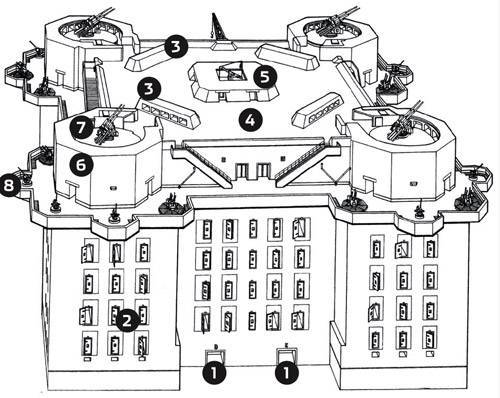
Concrete giant
1) Entry 2) Armored shutters 3) Ammunition depots 4) Main combat platform 5) Command post and rangefinder 6) Cannon turrets 7) 128-mm dual anti-aircraft gun 8) Light 20-mm anti-aircraft gun
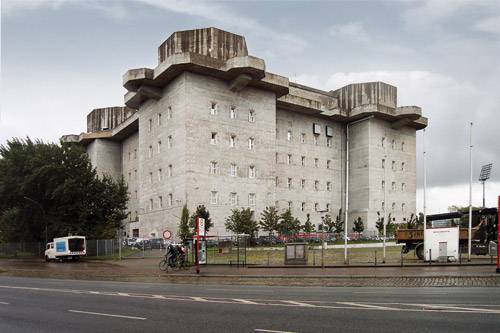
Tower "G"
The most impressive of all anti-aircraft towers - the first generation of the “G” towers - stood in Berlin and Hamburg. The only surviving structure in this series. The building stands in the Heiligengaysfeld (Hamburg) district and is used as a residential building.
Anti-aircraft guns in the city
Back in the pre-war period, German experts turned their attention to a very significant factor that seriously interfered with the actions of anti-aircraft artillery. This factor turned out to be the cities of Germany themselves. They, like in most European countries, were built up with multi-storey buildings, and the distances between the buildings were often left minimal, and sometimes they were completely absent. It was possible to walk a kilometer or more down the street without seeing a single gap between the houses. And the streets themselves, especially in the old quarters, had a very small width.
Anti-aircraft batteries, command posts, observation points, as specialists from the Goering Office believed, needed to be placed not only on the approaches, but also inside the cities of the Reich, especially such large ones as Berlin, Hamburg, Bremen, Vienna. Meanwhile, just in these cities there was very little space for air defense facilities. In fact, only city squares, parks, and stadiums could be used to place the batteries. At the same time standing around the high houses significantly limited not only the vertical angles and sectors of shelling guns, but even the possibility of aiming. The bomber was visible to the gunner in a matter of seconds, during which it was impossible to determine with sufficient accuracy the course and speed of the target, enter the necessary data for firing even when using PUAZO (anti-aircraft fire control device).
The solution to all problems lay on the surface - more precisely, at the level of the roofs of houses. If you place command posts, detection devices, the guns themselves at this height, the approaching aircraft can be seen at a sufficient distance, you can accurately determine their course, height, speed, types of aircraft, their construction. This is extremely necessary, since remote observation posts can only provide approximate, approximate data. And here, commanders have time to make decisions and submit appropriate commands, and for calculations, to set the response time on the fuses, load the guns, introduce necessary corrections into the sights, carefully aim and open fire in time.
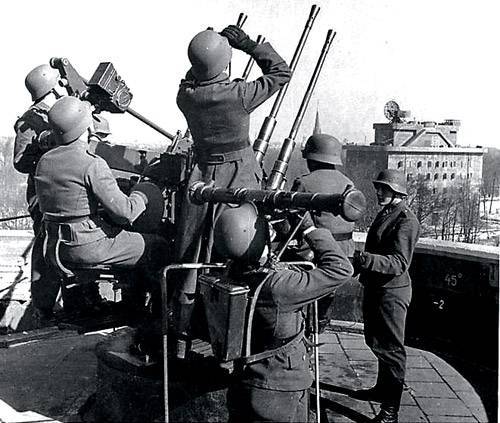
Waiting for a raid
1942 year. The Luftwaffe anti-aircraft gunners are preparing to repel an airstrike in the combat position of the G tower in Tiergarten (Berlin). In the distance, you can see the tower "L" with a deployed antenna locator
Closer to the sky
But how to raise the air defense system to the desired height? In the Soviet documentaries devoted to the defense of our capital, there are more than once shots footage of the Red Army man standing on the roof of the Moscow Hotel, looking attentively at the distance through binoculars, and behind him the 37-millimeter anti-aircraft gun.
The British acted in approximately the same way, placing anti-aircraft machine guns on the roofs of houses, bell towers of churches and cathedrals back in World War I, when they had to repel raids by German zeppelins. However, during the Second World War, the Russians and the British still preferred to place most of their air defense systems at remote borders. Due to the continued mobility of their anti-aircraft weapons, they could maneuver them, focus them on the most important areas. True, it is worth noting that the Luftwaffe did not have the same air power as the Anglo-Americans. And it is not known how the fate of London or Moscow would have developed if the Nazis had a bomber comparable in combat capabilities aviation.
But how to raise guns over the city? There were only a few houses on the roofs of which it is possible to install anti-aircraft guns, at that time, both in Moscow and in Berlin. And the attic floor of any building could hardly withstand the weight of anti-aircraft guns with a caliber larger than 20 – 37 mm. About guns caliber 88 mm, weighing 8 – 9 t, can not speak.
In Germany, the solution to the problem of placing anti-aircraft guns at the level of city roofs was felt in 1935, when architect Leo Winkel developed a completely unexpected construction of bomb shelters for the population. He suggested not to bury shelters in the ground, but to build them in the form of tall and narrow towers. Soon the first projects of such towers appeared (WinkeltЯrme). Outwardly, these were cone-shaped multi-storey reinforced concrete structures, similar to termitaries or to rockets. Their capacity ranged from 300 to 750 people. Occupying a minimum area, the towers could be built fairly close to crowded places — for example, near schools, factory workshops, in residential areas. With the same consumption of materials as for underground shelters, Winkel towers removed a lot of problems associated with earthworks, groundwater, underground utilities, which are usually so many in the cities. The probability of a bomb entering the tower is relatively small. Moreover, its shape is such that even a bomb that falls on a tower slides along its outer wall, without penetrating inside. And high resistance to close explosions of structures like factory chimneys is well known. After all, even in Hiroshima after a nuclear explosion, the pipes survived where everything else was swept away by the shock wave. The Winkel Tower was supposed to be pivotally fastened to the foundation in the form of a slab, lying loose on the ground. With close explosions of any bombs, she could swing like a pipe, and that was exactly what saved her from destruction, and people from destruction.
Time will reveal another protective factor of the Winkel towers. With massive air raids, when mass fires began in the city, people died in many underground shelters from carbon monoxide, which, as we know, spreads low. Sheltered in the towers of Winkel were protected from this horror.
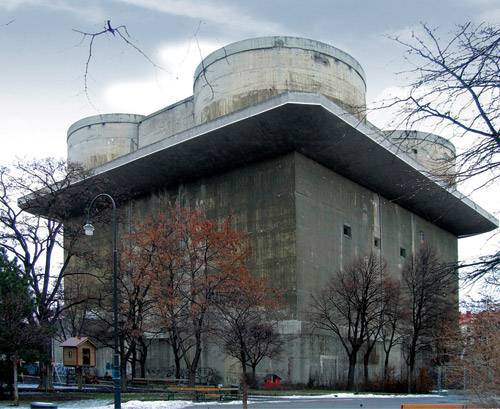
Viennese bastion
Thus, the tower “G” of the Flakturm VIII complex, preserved in the Arenberg park in Vienna, has survived to this day. Her "sister", also belonging to the second generation of anti-aircraft towers, stands in Wilhelmsburg - an area of Hamburg
Concrete fortresses
Already in 1937, Winkel’s projects aroused great interest among the command of the Luftwaffe, the Wehrmacht and the railway workers. The Goering Office began building towers at the aviation industry enterprises, calling them “Luftschutztürme” (Luftschutztürme). The Luftwaffe built 29 of such towers, the railway workers - 17. The Wehrmacht built 34 towers for its command posts in Potsdam and Zossen. A significant number of towers were erected by firms engaged in the manufacture of military products.
In October, 1940, Hitler ordered the construction of such bomb shelters (designed by Winkel and his rival Paul Zombek) for the population of cities. They should have contained at least 5% of the total number of citizens.
When the German specialists seriously started developing the German air defense system and, in particular, the anti-aircraft defense of large cities, they did not lose sight of the Winckel bomb shelter and offered to build special structures called Flakärme anti-aircraft towers.
The design of these anti-aircraft towers was taken up by Hitler’s favorite architect Albert Speer, who by August 1940 had proposed the first designs approved by the Fuhrer. The erection of anti-aircraft towers was entrusted to the state-owned military-industrial corporation Organization Todt, known in particular for the construction of the German autobahns.
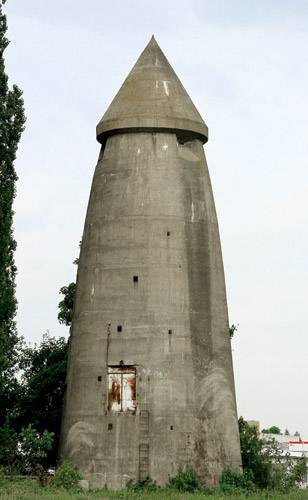
Meet bombs
Concrete bomb shelters designed by Leo Winckel, somewhat reminiscent of the phallic megaliths of primitive times, proved to be very effective shelters that protected both from bombs and from poisoning by combustion products
Womb of the stronghold
Let us consider in more detail one of the “G” towers — the Heiligenhgefeld Tower IV built in Hamburg. It is almost similar to all three Berlin ones, but, unlike them, it has survived to the present day.
The tower was a seven-story reinforced concrete building, square in plan. Side of the square - 60 m. Height (at gun grounds) - 39 m. The garrison of the tower consisted of 8000 people. Of these, the calculations of anti-aircraft guns - about 300 people. In addition to the garrison in the tower during the air raid could hide up to 18 000 civilians.
For life support, the tower had its own autonomous diesel-generator power station with a capacity of 100 kW, an autonomous water supply system with water from a well, and a kitchen. On one of the floors there was a hospital on 200 beds. The ground floor was intended for the preservation of artistic and cultural values from museums and art galleries. According to some information in complex I in Berlin, they sheltered the archaeological collection of Heinrich Schliemann, known in the world as the “gold of Troy”.
The thickness of interfloor overlappings reached 2 m, the roof — up to 2,5 m, walls — 2 – 2,5 m. This provided protection against direct hits of high-explosive air bombs weighing up to 1 t.
Heavy anti-aircraft guns were located at the top of the building in special concrete turrets. Below each heavy anti-aircraft guns on the platforms surrounding the turrets were placed three single-barrel 20-mm anti-aircraft guns and two quadruple ones. Their main task was to protect heavy guns from attack aircraft such as Thunderbolt or Tempest. In the center of the roof of the building was located the command post.
Mechanized ammunition supply systems from the lower floors of the building, which served as artillery grabs, were borrowed from the Navy and ensured the uninterrupted supply of projectiles and the removal of spent cartridges for a long time. All mechanisms were electrified.
These towers were not conceived and equipped as strongholds against ground forces, since it was clear that they would not be able to withstand heavy artillery.
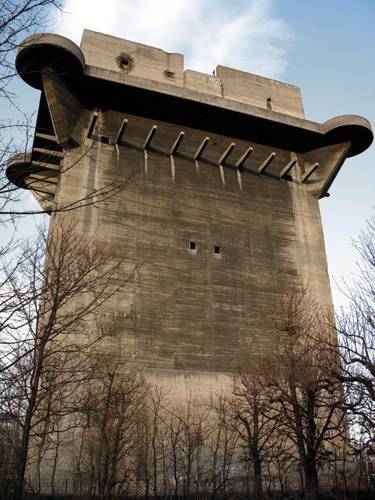
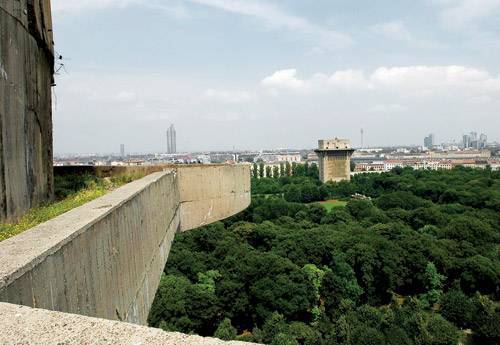
Tower "L" of complex VII in Vienna (left) is empty, but it is possible that a computing center will be placed there over time. In the left part of the frame is the tower "G" of complex VIII (Vienna), which is used as a repository for works of art. Away - the tower “L”
Castle with aquarium
Of course, these powerful and solid fortresses amazed the imagination, inspired reverence for the national socialist state and instilled in the Germans that Hitler's genius, the fighters and Goering anti-aircraft guns, the builders of Todt and Speer would ensure their safety and invulnerability.
However, the ideological significance of the anti-aircraft towers, apparently, far exceeded their purely military sense. 24 July 1943, the Anglo-American Bomber began bombing Hamburg. By 3 August, almost 43 000 residents were killed and 37 000 were injured. The city was completely destroyed. In a single 3 raid on February 1945 of the year, 25 000 people died in Berlin. February 26 Berlin survived the already fortieth massive airstrike. The scale of the bombing proved to be such that they could not seriously oppose them to the Luftwaffe. When the Soviet troops approached the Oder, preparing for a decisive assault, not only the Anglo-American high-altitude bombers began to make raids on the German capital, but also low-flying attack aircraft with red stars. Trying to repel the attacks of the Soviet pilots, the German anti-aircraft gunners were forced to shoot at a trajectory close to the horizontal, and because of the rupture of anti-aircraft shells at low altitude, the civilian population of Berlin suffered new terrible casualties.
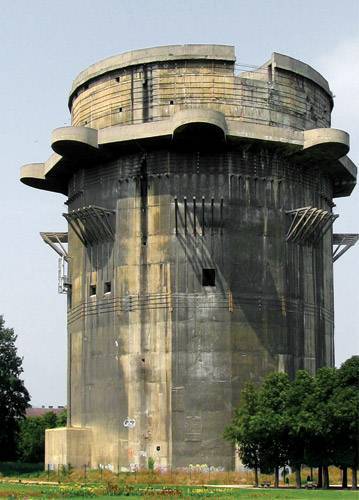
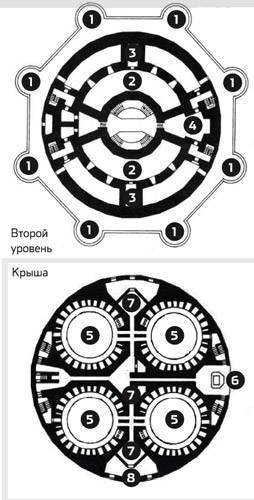
Inside look
The diagram shows the roof and the second from the top level of the tower "G" of complex VII in Vienna
1) Location of light anti-aircraft artillery 2) Storage for ammunition 3) Elevators for ammunition 4) Engine for lifts 5) Recess for anti-aircraft guns 6) Crane 7) Firing position 8) Machine compartment
Anti-aircraft towers, which embodied the primordial Teutonic gloom and at the same time the original train of thought of German fortification engineers, can be seen today. In Vienna and Hamburg all five “G” towers and three “L” towers (all in Vienna) are preserved. One of them even has an aquarium.
The fate of the Berlin towers is different. The city was divided into allied zones, and the union of the winners was soon broken by the “iron curtain”: the cold war began. The Western allies and the USSR mutually feared that yesterday's comrades in the war would use towers against each other, primarily for intelligence purposes. This led to the fact that all three complexes were demolished. However, the remains of some towers are still preserved to this day.
Information